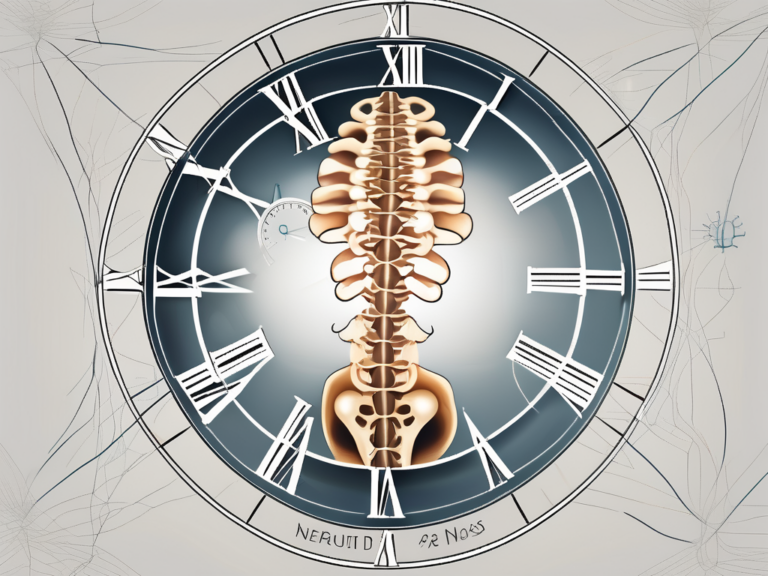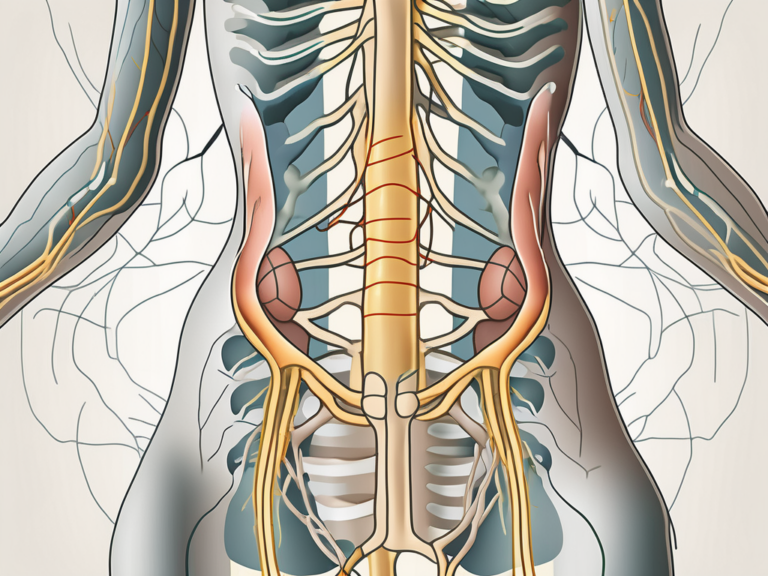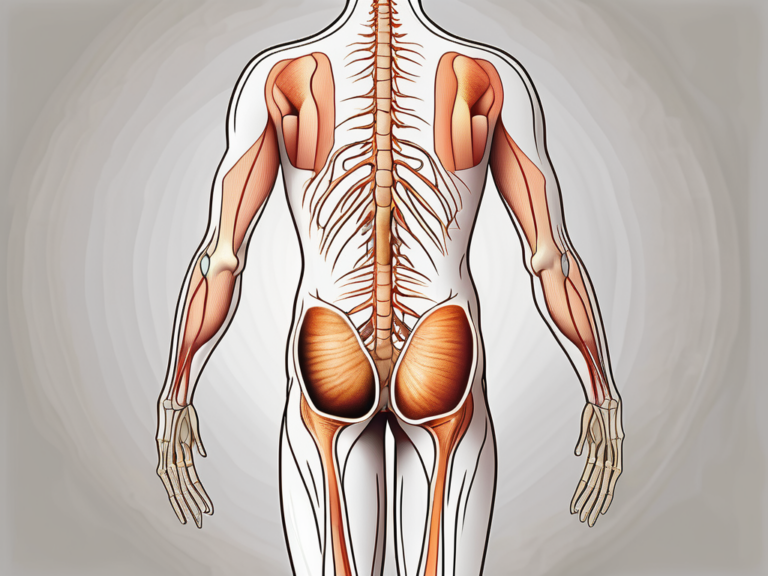Exercises for Symptomatic Sacral Tarlov Nerve Root Cysts: What Can You Do?
Sacral Tarlov Nerve Root Cysts can cause significant discomfort and disrupt daily activities. While there is no cure for this condition, incorporating specific exercises into your routine can help manage symptoms and improve your quality of life. In this article, we will explore different types of exercises and their benefits for Sacral Tarlov Nerve Root Cysts. However, it is important to note that before starting any exercise program, you should consult with your healthcare provider to ensure it is suitable for your individual condition and needs.
Understanding Sacral Tarlov Nerve Root Cysts
Sacral Tarlov Nerve Root Cysts are fluid-filled sacs that develop on the nerve roots in the sacrum, the triangular bone at the base of the spine. These cysts can cause pressure on the nerves, leading to symptoms such as pain, numbness, and weakness in the lower back, buttocks, and legs.
The sacrum, also known as the sacral bone, is a vital structure that connects the spine to the pelvis. It consists of five fused vertebrae and plays a crucial role in providing support and stability to the upper body. The nerve roots emerging from the sacrum are responsible for transmitting signals to and from the lower extremities, allowing for movement and sensation.
Symptoms and Diagnosis of Sacral Tarlov Nerve Root Cysts
Common symptoms of Sacral Tarlov Nerve Root Cysts include chronic pain in the lower back or buttocks, numbness or tingling in the legs, difficulty walking or standing for long periods, and muscle weakness. These symptoms can vary in severity and may worsen over time if left untreated.
Diagnosing Sacral Tarlov Nerve Root Cysts can be challenging, as the symptoms can mimic those of other spinal conditions. A comprehensive evaluation by a healthcare professional is crucial to accurately diagnose the condition. The evaluation may include a thorough medical history review, physical examination, and diagnostic tests such as magnetic resonance imaging (MRI) or computed tomography (CT) scans.
Causes and Risk Factors of Sacral Tarlov Nerve Root Cysts
The exact cause of Sacral Tarlov Nerve Root Cysts is not fully understood. However, they are believed to develop due to weakening or stretching of the nerve root sheaths in the sacrum. These sheaths, also known as the dura mater, are protective coverings that surround the nerve roots and help maintain their integrity.
Several risk factors have been associated with the development of Sacral Tarlov Nerve Root Cysts. Trauma to the spine, such as falls or accidents, can lead to the formation of these cysts. Additionally, previous back surgeries, especially those involving the sacrum, may increase the risk. There is also evidence to suggest a genetic predisposition, with some individuals being more prone to developing these cysts than others.
It is important to note that Sacral Tarlov Nerve Root Cysts are considered a rare condition, and not everyone with the identified risk factors will develop them. Further research is needed to fully understand the underlying mechanisms and identify additional risk factors that may contribute to the formation of these cysts.
The Role of Exercise in Managing Sacral Tarlov Nerve Root Cysts
Exercise can play a vital role in managing Sacral Tarlov Nerve Root Cysts by relieving pain, improving flexibility, strengthening muscles, and enhancing overall physical well-being. It is essential to approach exercise with caution and seek guidance from a healthcare professional or a trained physical therapist.
Benefits of Exercise for Sacral Tarlov Nerve Root Cysts
Regular exercise can provide numerous benefits for individuals with Sacral Tarlov Nerve Root Cysts. It can help reduce pain and inflammation, improve range of motion, strengthen muscles to support the spine, and promote overall physical and mental well-being. By engaging in appropriate exercises, individuals can experience an improvement in their quality of life and better manage the symptoms associated with this condition.
One of the primary benefits of exercise for Sacral Tarlov Nerve Root Cysts is pain relief. When performed correctly, certain exercises can help alleviate pain and discomfort by releasing endorphins, which are the body’s natural painkillers. Additionally, exercise promotes the production of synovial fluid, which lubricates the joints and reduces friction, leading to decreased pain and improved mobility.
Furthermore, regular exercise can improve flexibility, which is crucial for individuals with Sacral Tarlov Nerve Root Cysts. Stretching exercises can help increase the range of motion in the affected area, reducing stiffness and enhancing overall mobility. Improved flexibility also allows individuals to perform daily activities with greater ease and reduces the risk of further injury.
Another significant benefit of exercise is the strengthening of muscles that support the spine. Strong muscles in the back, abdomen, and pelvis can help stabilize the spine and alleviate pressure on the affected nerve roots. By incorporating exercises that target these muscle groups, individuals can improve their posture, reduce strain on the spine, and enhance their overall physical strength.
Moreover, exercise has a positive impact on mental well-being. Engaging in physical activity releases endorphins, which are known as “feel-good” hormones. These endorphins can help reduce stress, anxiety, and depression, which are often associated with chronic pain conditions. Regular exercise can also improve sleep quality, boost self-esteem, and provide a sense of accomplishment and empowerment.
Precautions to Take When Exercising with Sacral Tarlov Nerve Root Cysts
While exercise can be beneficial, it is important to take certain precautions to avoid further injury or aggravation of symptoms. Start slowly and gradually increase the intensity and duration of your workouts. It is crucial to listen to your body and stop any exercise that causes pain or discomfort. Pushing through pain can worsen the condition and lead to additional complications.
Consulting with a healthcare professional or a physical therapist is highly recommended before starting an exercise program. They can provide personalized guidance and create an exercise plan tailored to your individual needs and limitations. A professional can also teach you proper techniques and modifications to ensure that you are performing exercises correctly and safely.
When exercising with Sacral Tarlov Nerve Root Cysts, it is essential to choose activities that are low-impact and gentle on the spine. Walking, swimming, and cycling are excellent options as they provide cardiovascular benefits without placing excessive strain on the affected area. Additionally, exercises that focus on core strength, such as Pilates or yoga, can help improve stability and support the spine.
It is crucial to avoid high-impact activities, such as running or jumping, as they can jar the spine and worsen symptoms. Similarly, exercises that involve heavy lifting or twisting motions should be avoided as they can strain the affected area and potentially cause further damage.
In conclusion, exercise is a valuable tool in managing Sacral Tarlov Nerve Root Cysts. When performed correctly and under the guidance of healthcare professionals, exercise can provide pain relief, improve flexibility, strengthen muscles, and enhance overall physical and mental well-being. By taking precautions and engaging in appropriate exercises, individuals can take an active role in managing their condition and improving their quality of life.
Different Types of Exercises for Sacral Tarlov Nerve Root Cysts
When it comes to managing Sacral Tarlov Nerve Root Cysts, a combination of stretching, strength-building, and balance and coordination exercises can be beneficial. Remember to consult with a healthcare professional or a physical therapist to determine the most suitable exercises for your individual needs.
Stretching Exercises for Sacral Tarlov Nerve Root Cysts
Stretching exercises can help improve flexibility, reduce muscle stiffness, and relieve pain associated with Sacral Tarlov Nerve Root Cysts. Gentle stretches that focus on the lower back, hips, and legs can be particularly beneficial. Examples of stretching exercises include hamstring stretches, quadriceps stretches, and gentle lower back stretches. When performing stretches, it is important to avoid any sudden or jerking movements that could potentially worsen symptoms.
Hamstring stretches involve sitting on the floor with one leg extended in front of you and the other leg bent with the foot resting against the inner thigh. Slowly lean forward, reaching towards your toes while keeping your back straight. Hold the stretch for 30 seconds and repeat on the other leg.
Quadriceps stretches can be done by standing near a wall or holding onto a chair for support. Bend one knee and bring your foot towards your buttocks, grasping your ankle with your hand. Gently pull your foot towards your buttocks until you feel a stretch in the front of your thigh. Hold for 30 seconds and repeat on the other leg.
Gentle lower back stretches can be performed by lying on your back with your knees bent and feet flat on the floor. Slowly bring one knee towards your chest, using your hands to gently pull it closer. Hold for 30 seconds and repeat on the other leg.
Strength-Building Exercises for Sacral Tarlov Nerve Root Cysts
Strengthening the muscles that support the spine can help improve stability and reduce the pressure on the affected nerves. Low-impact exercises that target the core, hips, and thighs can be effective. Examples of strength-building exercises include abdominal exercises like planks or pelvic tilts, leg presses, and bridges. It is crucial to maintain the correct form throughout these exercises and start with light resistance or bodyweight before gradually increasing the intensity.
Abdominal exercises like planks involve supporting your body weight on your forearms and toes, keeping your body in a straight line. Hold this position for 30 seconds to a minute, focusing on engaging your core muscles. Pelvic tilts can be performed by lying on your back with your knees bent and feet flat on the floor. Slowly tilt your pelvis forward and backward, focusing on using your abdominal muscles to initiate the movement.
Leg presses can be done using a leg press machine or resistance bands. Sit with your back against a backrest and place your feet on the footplate. Push the footplate away from you, extending your legs, and then slowly return to the starting position. Bridges involve lying on your back with your knees bent and feet flat on the floor. Lift your hips off the ground, squeezing your glutes and engaging your core. Hold for a few seconds and then lower back down.
Balance and Coordination Exercises for Sacral Tarlov Nerve Root Cysts
Balance and coordination exercises can improve stability and reduce the risk of falls in individuals with Sacral Tarlov Nerve Root Cysts. Various exercises targeting balance, such as standing on one leg or using a stability ball, can be beneficial. Additionally, gentle movements that focus on coordination, such as tai chi or yoga, can help improve fluidity of motion and promote overall well-being. It is essential to perform these exercises with caution and have support, if needed, to prevent falls or injuries.
Standing on one leg can be done by lifting one foot off the ground and balancing on the other leg. Start by holding onto a wall or a sturdy object for support and gradually work towards balancing without any assistance. Using a stability ball involves sitting or lying on the ball and performing various exercises while maintaining balance. This can help improve core strength and stability.
Tai chi and yoga are both practices that focus on gentle movements, balance, and coordination. Tai chi involves a series of slow, flowing movements that promote relaxation and improve balance. Yoga combines physical postures, breathing exercises, and meditation to enhance flexibility, strength, and balance. Both tai chi and yoga can be modified to suit individual needs and abilities.
Creating a Personalized Exercise Plan
Each individual’s exercise plan should be tailored to their specific needs and capabilities. Consulting with a physical therapist who specializes in treating Sacral Tarlov Nerve Root Cysts can provide valuable guidance and support in creating a personalized exercise plan.
Consulting with a Physical Therapist
A physical therapist can assess your condition, discuss your goals, and create an exercise program that addresses your specific needs. They can guide you through proper exercise techniques, monitor your progress, and modify your plan as necessary. The expertise of a physical therapist can be invaluable in ensuring a safe and effective exercise routine.
When consulting with a physical therapist, they will conduct a thorough evaluation of your condition. They will assess your range of motion, strength, and flexibility to determine the best exercises for you. They will also take into consideration any limitations or restrictions you may have due to your Sacral Tarlov Nerve Root Cysts. This personalized approach ensures that your exercise plan is tailored to your unique circumstances.
In addition to creating an exercise plan, a physical therapist can also provide education on proper body mechanics and postural alignment. This can help prevent injuries and maximize the benefits of your workouts. They may also incorporate other treatment modalities such as manual therapy or electrical stimulation to further enhance your progress.
Incorporating Exercise into Your Daily Routine
To make exercise a part of your daily routine, start by setting realistic goals and gradually increasing the duration and intensity of your workouts. Find activities that you enjoy and make them a priority in your schedule. Whether it’s walking, swimming, or participating in a yoga class, finding activities that are enjoyable can help you stay motivated and committed to your exercise routine.
When incorporating exercise into your daily routine, it’s important to listen to your body and not push yourself too hard. It’s normal to experience some discomfort or muscle soreness, especially when starting a new exercise program, but it’s important to differentiate between normal discomfort and pain. If you experience pain during or after exercise, it’s important to consult with your physical therapist to make appropriate modifications to your plan.
In addition to structured exercise sessions, finding ways to incorporate physical activity into your daily life can also be beneficial. This can include taking the stairs instead of the elevator, parking farther away from your destination to get some extra steps in, or doing household chores that require physical effort. These small lifestyle changes can add up and contribute to your overall fitness level.
Remember, consistency is key when it comes to exercise. Aim for at least 150 minutes of moderate-intensity aerobic activity or 75 minutes of vigorous-intensity aerobic activity per week, along with strength training exercises at least twice a week. By making exercise a regular part of your routine and working closely with a physical therapist, you can create a personalized exercise plan that promotes your overall health and well-being.
Monitoring Progress and Adjusting Your Exercise Plan
Regularly monitoring your progress is essential to determine the effectiveness of your exercise plan and make any necessary adjustments. Keep track of any improvements in pain levels, range of motion, strength, and overall well-being. If you experience any increase in pain or other symptoms, consult with your healthcare provider or physical therapist to modify your exercise plan as needed.
Signs of Improvement and Progress
Signs of improvement and progress may include reduced pain levels, increased flexibility and range of motion, improved muscle strength, and enhanced functional abilities. However, it is crucial to note that everyone’s progress may vary, and it is important to focus on your individual goals and abilities rather than comparing yourself to others.
When to Modify Your Exercise Plan
If you experience increased pain, new or worsening symptoms, or any other concerns, it is important to consult with your healthcare provider or physical therapist to modify your exercise plan. They can assess your condition, recommend appropriate modifications, and guide you through exercises that are more suitable for your current needs.
Other Non-Surgical Treatment Options
In addition to exercise, there are other non-surgical treatment options that may be recommended based on your individual condition. Pain management techniques, such as physical therapy modalities, medications, or nerve blocks, can help alleviate symptoms. Lifestyle changes, including proper posture, weight management, and stress reduction techniques, can also support the treatment of Sacral Tarlov Nerve Root Cysts.
Pain Management Techniques for Sacral Tarlov Nerve Root Cysts
Pain management techniques, recommended by healthcare providers, can help control pain and improve daily functioning. These may include heat or cold therapy, transcutaneous electrical nerve stimulation (TENS), ultrasound therapy, or medications aimed at reducing pain and inflammation. It is important to consult with your healthcare provider to determine the most appropriate pain management techniques for your individual situation.
Lifestyle Changes to Support Treatment of Sacral Tarlov Nerve Root Cysts
Alongside exercise and pain management techniques, certain lifestyle changes can support the treatment of Sacral Tarlov Nerve Root Cysts. Maintaining good posture, avoiding prolonged sitting or standing, and practicing stress reduction techniques can help reduce symptoms. Additionally, maintaining a healthy weight and following a balanced diet can support overall well-being and potentially reduce strain on the affected nerves.
Managing symptomatic Sacral Tarlov Nerve Root Cysts requires a comprehensive approach that includes exercise, pain management techniques, and lifestyle modifications. Incorporating appropriate exercises into your routine, under the guidance of a healthcare professional or physical therapist, can help alleviate symptoms, improve function, and enhance your overall quality of life. Remember to consult with your healthcare provider to ensure that the exercise plan is tailored to your individual needs and capabilities.




